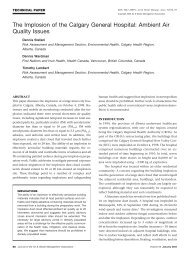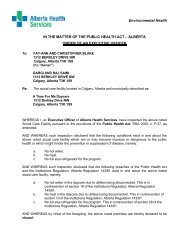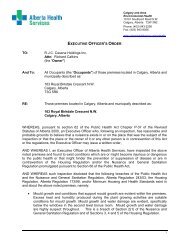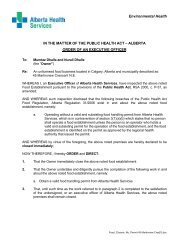Health Canada - Tattooing and Piercing - Alberta Health Services
Health Canada - Tattooing and Piercing - Alberta Health Services
Health Canada - Tattooing and Piercing - Alberta Health Services
Create successful ePaper yourself
Turn your PDF publications into a flip-book with our unique Google optimized e-Paper software.
<strong>Health</strong><br />
<strong>Canada</strong><br />
Santé<br />
<strong>Canada</strong><br />
The Issue<br />
<strong>Tattooing</strong> <strong>and</strong> ear/body piercing are<br />
increasingly popular among Canadians.<br />
These procedures, however, may<br />
increase the risk of contracting a number<br />
of serious blood-borne diseases.<br />
Background<br />
It’s Your <strong>Health</strong><br />
TATTOOING AND PIERCING<br />
Tattoos <strong>and</strong> ear/body piercings are very<br />
popular, especially among those aged 18<br />
to 22. Between 73 <strong>and</strong> 83 percent of<br />
women in the U.S. have had their ears<br />
pierced. An American university survey<br />
in 2001 found that 51 percent of students<br />
had piercings <strong>and</strong> 23 percent had tattoos.<br />
U.S. studies show that the number<br />
of women with tattoos quadrupled<br />
between 1960 <strong>and</strong> 1980. The number of<br />
tattooing <strong>and</strong> piercing shops in <strong>Canada</strong><br />
has increased dramatically in the last<br />
few years.<br />
<strong>Health</strong> Risks of <strong>Tattooing</strong><br />
<strong>and</strong> Ear/Body <strong>Piercing</strong><br />
Skin <strong>and</strong> mucous membranes in the<br />
mouth <strong>and</strong> nose protect you from many<br />
infections. Both tattooing <strong>and</strong> ear/body<br />
piercing procedures involve piercing the<br />
skin or mucous membrane with a needle<br />
or other sharp instrument. Unless the<br />
needles are new, sterilized for each<br />
treatment <strong>and</strong> properly h<strong>and</strong>led by the<br />
practitioner, instruments can be<br />
contaminated with the infected blood or<br />
bodily fluids of another person. You may<br />
also have bacteria or viruses present<br />
on your skin that can enter your body <strong>and</strong><br />
cause infection when your skin is pierced.<br />
Practitioners who do the tattooing <strong>and</strong><br />
piercing are also at risk of becoming<br />
infected through accidental cuts <strong>and</strong><br />
punctures.<br />
It is possible to transmit viral infections<br />
such as hepatitis B, hepatitis C, Human<br />
Immunodeficiency Virus (HIV)/Acquired<br />
Immunodeficiency Syndrome (AIDS) <strong>and</strong><br />
herpes through tattooing <strong>and</strong> piercing, as<br />
well as bacterial skin infections such as<br />
Streptococcus <strong>and</strong> Staphylococcus.<br />
Minimizing your Risk<br />
The best protection against disease <strong>and</strong><br />
infection is to carefully choose where<br />
you obtain your tattoo or piercing. Here<br />
is a list of conditions on which to base<br />
your decision:<br />
• The work area is clean <strong>and</strong> brightly<br />
lit.<br />
• The shop uses instruments that are<br />
easily cleaned <strong>and</strong> sterilized, such as<br />
stainless steel.<br />
• <strong>Tattooing</strong> is done with sterile needles<br />
in a tattoo machine that has been<br />
wiped with alcohol after each use<br />
<strong>and</strong> covered with new disposable<br />
plastic.<br />
• Ear piercing is done with a sterile<br />
needle or a gun that has a<br />
disposable sterile cartridge to<br />
holds the studs.<br />
• Tattoo <strong>and</strong> piercing needles are new<br />
<strong>and</strong> sterile for each treatment. They<br />
should never be reused.
<strong>Health</strong><br />
<strong>Canada</strong><br />
•Those performing the<br />
procedure have clean working<br />
habits, including washing<br />
their h<strong>and</strong>s before <strong>and</strong> after<br />
procedures, after h<strong>and</strong>ling<br />
contaminated items, before<br />
opening <strong>and</strong> h<strong>and</strong>ling sterile<br />
supplies, <strong>and</strong> before putting<br />
on <strong>and</strong> after removing their<br />
gloves.<br />
• Practitioners wear medical<br />
gloves during the procedures.<br />
• The shop has a “clean zone”<br />
<strong>and</strong> a “dirty zone.” The<br />
procedure should be done in<br />
the clean zone where only<br />
sterilized packages <strong>and</strong><br />
clean equipment are kept <strong>and</strong><br />
used. The dirty zone is the<br />
contaminated area where<br />
there is a washing sink <strong>and</strong><br />
holding basin for disinfecting<br />
implements.<br />
• Work surfaces are made of<br />
smooth <strong>and</strong> non-porous<br />
materials.<br />
• All surfaces are cleaned with<br />
a solution of bleach <strong>and</strong><br />
water.<br />
• The shop has a sterilizing<br />
machine, preferably a steam<br />
sterilizer, <strong>and</strong> test strips are<br />
used to indicate whether the<br />
machine is operating correctly.<br />
•Waste is disposed of properly,<br />
with blood-contaminated<br />
waste placed in plastic<br />
bags <strong>and</strong> tied before being<br />
added to the regular waste.<br />
• Sharp implements used to<br />
pierce the skin are put into<br />
puncture-resistant containers.<br />
• Oral <strong>and</strong> written instructions<br />
are given to clients for<br />
personal care after the<br />
procedure.<br />
Santé<br />
<strong>Canada</strong> It’s Your <strong>Health</strong><br />
You can minimize your own risk<br />
of infection by taking these<br />
precautions:<br />
• Choose a good professional<br />
practitioner who has been<br />
trained.<br />
• Ask the practitioner if she or<br />
he follows the Infection<br />
Control Guidelines for tattooing<br />
<strong>and</strong> ear/body piercing.<br />
• Never tattoo or pierce skin<br />
that has a cut or break,<br />
pimples, warts, or other<br />
abnormalities.<br />
• Make sure the practitioner<br />
disinfects the skin area using<br />
a skin antiseptic before the<br />
procedure.<br />
• Wash your h<strong>and</strong>s thoroughly<br />
before you apply lotions or<br />
ointments to the tattooed or<br />
pierced area after the<br />
procedure or when rotating<br />
the jewelry, as directed by<br />
the practitioner. If you are<br />
concerned that the tattoo or<br />
piercing is infected, contact your<br />
doctor or local health unit.<br />
• Hepatitis B vaccine will help<br />
protect you from hepatitis B,<br />
but there is no vaccine for<br />
hepatitis C or HIV.<br />
<strong>Health</strong> <strong>Canada</strong>’s<br />
Role<br />
Working in partnership with the<br />
provincial <strong>and</strong> territorial<br />
governments, <strong>Health</strong> <strong>Canada</strong><br />
has created Infection Control<br />
Guidelines for tattooing <strong>and</strong> ear/body<br />
piercing. These guidelines were<br />
developed for practitioners of<br />
tattooing <strong>and</strong> ear/body piercing by<br />
representatives from industry,<br />
health services, <strong>and</strong> <strong>Health</strong><br />
April 2003 ©Her Majesty the Queen in Right of <strong>Canada</strong>, represented by the Minister of <strong>Health</strong>, 2003<br />
<strong>Canada</strong>’s Centre for Infectious<br />
Disease Prevention <strong>and</strong> Control.<br />
Need More Info?<br />
To learn more about <strong>Health</strong><br />
<strong>Canada</strong>’s Infection Control<br />
Guidelines, visit:<br />
http://www.hc-sc.gc.ca/<br />
pphb-dgspsp/publicat/ccdr-rmtc/<br />
99vol25/25s3/index.html<br />
<strong>and</strong><br />
http://www.hc-sc.gc.ca/<br />
pphb-dgspsp/publicat/ccdr-rmtc/<br />
99vol25/dr2520eb.html<br />
For information on hepatitis C,<br />
visit:<br />
http://www.hc-sc.gc.ca/hppb/<br />
hepatitis_c/<br />
See also the It’s Your <strong>Health</strong><br />
article on hepatitis C<br />
http://www.hc-sc.gc.ca/english/<br />
iyh/diseases/hepc.html<br />
For information on the Canadian<br />
Strategy on HIV/AIDS, visit:<br />
http://www.hc-sc.gc.ca/hppb/<br />
hiv_aids/<br />
Additional It’s Your <strong>Health</strong> articles<br />
can be found at:<br />
www.healthcanada.ca/iyh<br />
You can also call (613) 957-2991












